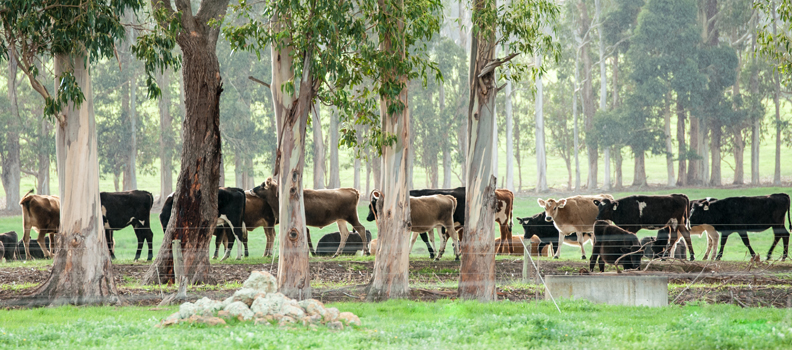Lower the Stress of Weaning Time – Calmer Cattle are More Productive

Weaning is naturally a stressful time for both cows and calves; if high stress is endured throughout the weaning process this can affect the health of the weaner.
If a weaner is highly stressed this can compromise their immune system, which may allow bacteria into their systems, resulting in illness and disease. Another important factor to help reduce infection is to keep the dust down, which will assist in reducing eye and respiratory infections.
Calm the Calves with Green Cap
Beachport Liquid Minerals has been involved in the livestock industry for over ten years, and we are aware of the loss of income related to high stress encountered at weaning. This is why the Green Cap formulation is aimed at naturally calming livestock to assist in ways of coping with stress during weaning and trucking.
Weaning is Much More Than Separating Calves from Cows
But paired with good management practices it will optimise in better cow condition, higher conception and tighten calving the following year. The optimum time to wean calves is dependent upon many aspects such as season/ environment, management practices, the condition of the cows as well as the target market the calves are aimed towards. There are many methods that can be used when it comes to weaning, the best method is the method that fits into your operation and management practice. When it comes to weaning, it should be as stress-free as possible; however, when your animals are stressed you’re stressed.
9 Tips to a Successful Weaning
Management & organisation are the keys to a successful weaning. Here are some good management practices to put into place before your next weaning.
- In the week before weaning check all equipment, make sure that everything in the yards is working, gates, gate latches, troughs are working and clean, and feeders are in place. Also, ensure that fences are in order where the cows will go.
- Know your numbers! This is to ensure you have enough help before the day starts and if you’re planning on vaccinating, drenching or tagging you have the correct amount of equipment prior to the day
- Spend time in the yards daily to allow the weaners to become accustomed to the interaction with people; such as feeding and slowly working them through the yards to educate them to move on their own without the cows before you start tailing out in less confined areas.
- Try to reduce any sudden movement, loud noise and pressure points when working in the yards during and after the calves have been weaned. This will reduce overcrowding within the yards and animals becoming squashed.
- Make note of weaners that are not settling as quickly as the others, especially if you plan on keeping them as replacements. If these animals remain flighty and highly strung around the other weaners, it would be suggested that you cull these out immediately. This can help calm the other weaners and over time you will gradually build a quieter and calmer herd.
- A good management practice when weaning is to separate heifers from steers, as both sexes put more weight on when running separately. If you have enough space, separate the smaller or poorer doing weaners as they require more nutrients. If left with the bigger mob it is often found that these calves are picked on and do not receive the amount of feed they require. These smaller poorer doing weaners usually have a less developed rumen. The Green Cap helps to kick-start the rumen and helps them to convert feed better, which will assist them in being a more productive animal in a shorter time.
- Make sure that there is sufficient high-quality feed available to the weaners; the Green Cap naturally calms them down and stimulates the rumen helping their rumens adjust to a new adult diet; slowly making them think more about eating and sleeping than thinking of their mothers. Slowly adjust them onto the new diet over a couple of days and do not abruptly change it, as you are allowing the microorganism to adjust to the change. A good quality hay should always be available to allow roughage for the microorganism to function.
- To reduce stress, make sure the weaners have access to clean fresh water all the time and dose the trough with the Green Cap using the dispenser as soon as you can to help them settle quickly. Make sure they are offered fresh feed every day and shade if available.
- Weaning is the ideal time to start to train and educate the weaners to act calmly in the yards and around people on a regular basis. This will help to establish quieter cattle in the future.
A Healthy Weaner, a Better Future
Using the Beachport Liquid Minerals Green Cap – with its formulation of blended amino acids, electrolytes and trace elements – allows the weaners to settle quickly, to better adjust their rumens to the new diet, and be far easier to handle and educate through the yards and tailing out. This means less time in the yards and less cost in labour and supplementary feeding. The benefits of using Green Cap at weaning include:
- Weaners cope better with separation and are easier to handle
- Weaners spend less time “sulking “and return to feed and water sooner
- Helps reduce weaning time and stimulates the rumen
- Aids with rumen adaption when there is a change in diet
- Green cap is readily absorbed by the rumen
- High amino acid content (protein building blocks)
- Assist with feed conversion of both dry and green feed
For more information on how Green Cap can help your livestock please contact your local Beachport Liquid Minerals Regional Manager.
Written by Kate Fairlie
B. Agricultural Science
